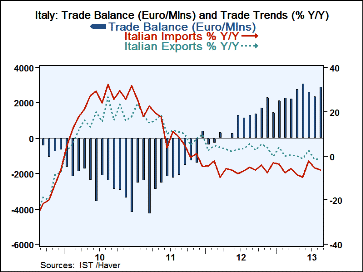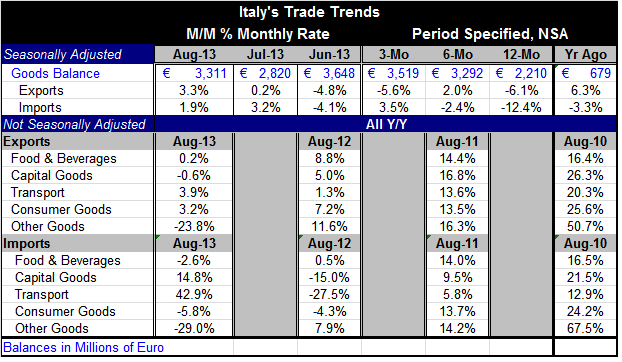 Global| Oct 16 2013
Global| Oct 16 2013Italy's Trade Balance Improves
Summary
Italy's trade balance improved in August. Both exports and imports rose month-to-month in August with exports up by 3,3% and imports up by 1.0%. Italian exports show a sharp drop in `other goods' a category that fell by 23.8% year- [...]
 Italy's trade balance improved in August. Both exports and imports rose month-to-month in August with exports up by 3,3% and imports up by 1.0%.
Italy's trade balance improved in August. Both exports and imports rose month-to-month in August with exports up by 3,3% and imports up by 1.0%.
Italian exports show a sharp drop in `other goods' a category that fell by 23.8% year-over-year. But exports of consumer goods and transportation equipment are up by 3% to 4%, on that horizon, while foods and beverages exports are just slightly higher on the year; capital goods exports have edged lower.
On the import side, transportation equipment exports are soaring, up by 42.9% year-over-year. Capital goods exports are strong too, rising by 14% on the year. But `other goods' exports are very weak, off by 29% on the year and consumer goods as well as foods and beverage exports are lower on that horizon as well.
Overall Italian export trends are erratic. They are off at a 5.6% annual rate over three-months but up at a 3% pace over six-months and still lower by 6.1% year-over-year.
Imports show signs of recovery from some real weakness. This could also be a signal that domestic demand is recovering. Imports are lower by 12.4% over 12-months. But their drop is only at a 2.4% pace over 6-months and over 3-months they are rising at a 3.5% annual rate. The recovery gradient is mild but it is in-place over three- and six-month horizons.
Italy's trade surplus continues to hover at a relatively high level. There are now 16 monthly surpluses in a row and a five-month smattering of near-balance figures following a long string of deficits.
However, the question for Italy and for other Mediterranean countries will be, "What happens when domestic growth picks up and imports begin to revive?" In the last 21 months year-over-year imports are lower in 19 of them. Much of the trade improvement in Italy is from domestic weakness and weak imports rather than from improved competitiveness. Economic revival in Italy may also come with weaker consumption patterns due to high indebtedness. But recognize that exports are only lower in nine of the last 21 months. That is why the trade balance has improved. The risk is that with economic revival in Italy, imports will recover faster than exports and that Italy's trade deficits will return. The progress will turn out to be mostly a cyclical Illusion.

Robert Brusca
AuthorMore in Author Profile »Robert A. Brusca is Chief Economist of Fact and Opinion Economics, a consulting firm he founded in Manhattan. He has been an economist on Wall Street for over 25 years. He has visited central banking and large institutional clients in over 30 countries in his career as an economist. Mr. Brusca was a Divisional Research Chief at the Federal Reserve Bank of NY (Chief of the International Financial markets Division), a Fed Watcher at Irving Trust and Chief Economist at Nikko Securities International. He is widely quoted and appears in various media. Mr. Brusca holds an MA and Ph.D. in economics from Michigan State University and a BA in Economics from the University of Michigan. His research pursues his strong interests in non aligned policy economics as well as international economics. FAO Economics’ research targets investors to assist them in making better investment decisions in stocks, bonds and in a variety of international assets. The company does not manage money and has no conflicts in giving economic advice.






